Edvard Munch
Edvard Munch (12 December 1863 – 23 January 1944) was a Norwegian painter and print-maker. He was born in Adalsbruk. He was an expressionist who painted 1789 known paintings. He is well known for his treatment of emotion such as fear. His way of seeing things had a large influence on the expressionism of the 20th century. People saw this treatment as being intense.

.jpg.webp)
During his life, he had success as a painter: He became famous outside Norway, and his paintings got high prices. The National Gallery (Norway) used much money to buy paintings by Munch.[1] He painted a large murals in the aula (main room) of Norway's (then) only university.
Early life and education
He had four brothers and sisters. He had followed his mother and sister by being the best artists in their family. While Edvard was still young, his mother and one of his sisters died. But it was when he was thirteen that he really came to like art. The first paintings he did were simple objects like medicine bottles and other objects. Later on, he drew oil paintings.
He went to technical college in 1879 where he learnt how to draw paintings with perspective. However, in 1880, the following year he left the school to become a painter.
He went to the Royal School of Art and Design. This is where he learnt sculpturing and naturalistic painting. This is where he drew his first important portrait of himself and his father.
Health and death
Munch was ill very often. Many scientists think that he suffered from bipolar disorder (manic depression). He died at his house in Oslo.
Paintings
The Scream (1893; originally called Despair). This is Munch's best-known painting, and is one of the best known images in the world. It is one of the pieces in a series titled The Frieze of Life. In the series Munch explored the themes of life, love, fear, death and melancholy. As with many of his works, he made several versions of the painting. One version was stolen from the Munch-museum in Oslo, Norway, on 22 August 2004, but on 31 August 2006 Norwegian police found it together with another picture that was stolen at the same time, Madonna.
The Frieze of Life themes come back throughout Munch's work. These themes can be seen in paintings such as The Sick Child (1886, portrait of his deceased sister Sophie), (1893–1894), Ashes (1894), and The Bridge. The last-named shows limp figures. Those figures have faces with no features, or they have no faces at all. Threatening shapes of heavy trees and houses are above the figures. Munch portrayed women either as frail, innocent sufferers or as lurid, life-devouring vampires. Munch analysts say this reflects his sexual anxieties.
.jpg.webp)
- 1885-86: The Sick Child
- 1892: Evening on Karl Johan
- 1893: The Scream
- 1894: Ashes
- 1894–1895: Madonna
- 1895: Puberty
- 1895: Self-Portrait with Burning Cigarette
- 1895: Death in the Sickroom
- 1899–1900: The Dance of Life
- 1899–1900: The Dead Mother
- 1903: Village in Moonlight
- 1940–1942: Self Portrait: Between Clock and Bed
- Some famous paintings
 The Scream. 1893. Oil, tempera, and pastel on cardboard. Nasjonalgalleriet, Oslo
The Scream. 1893. Oil, tempera, and pastel on cardboard. Nasjonalgalleriet, Oslo.jpg.webp) The Dance of Life. 1899–1900. Oil on canvas, 491⁄2 × 75 in. Nasjonalgalleriet, Oslo
The Dance of Life. 1899–1900. Oil on canvas, 491⁄2 × 75 in. Nasjonalgalleriet, Oslo.jpg.webp) Ashes. 1894. Oil on canvas. 120.5 × 141 cm. Nasjonalgalleriet, Oslo
Ashes. 1894. Oil on canvas. 120.5 × 141 cm. Nasjonalgalleriet, Oslo Madonna. 1894. Oil on canvas. 90 × 68 cm. Munch Museum, Oslo
Madonna. 1894. Oil on canvas. 90 × 68 cm. Munch Museum, Oslo
Other paintings
 The Seine at Saint-Cloud. 1890. 46 × 38 cm. Munch Museum, Oslo
The Seine at Saint-Cloud. 1890. 46 × 38 cm. Munch Museum, Oslo At the Roulette Table in Monte Carlo. 1892. 74,5 × 116 cm. Munch Museum, Oslo
At the Roulette Table in Monte Carlo. 1892. 74,5 × 116 cm. Munch Museum, Oslo
 Death in the Sickroom. 1893. 134 × 160 cm. Munch Museum, Oslo
Death in the Sickroom. 1893. 134 × 160 cm. Munch Museum, Oslo Starry Night. 1893. 135.6 × 140 cm. J. Paul Getty Museum.
Starry Night. 1893. 135.6 × 140 cm. J. Paul Getty Museum._-_Google_Art_Project.jpg.webp) Vampire. 1895. 91 × 109 cm. Munch Museum, Oslo
Vampire. 1895. 91 × 109 cm. Munch Museum, Oslo Anxiety. 1894. 94 × 74 cm. Munch Museum, Oslo
Anxiety. 1894. 94 × 74 cm. Munch Museum, Oslo Death in the Sickroom. c. 1895. Oil on canvas. 59 × 66 in. Nasjonalgalleriet, Oslo
Death in the Sickroom. c. 1895. Oil on canvas. 59 × 66 in. Nasjonalgalleriet, Oslo Lady From the Sea (detail). 1896. Oil on canvas. 391⁄2 × 126 in.
Lady From the Sea (detail). 1896. Oil on canvas. 391⁄2 × 126 in. Evening. Melancholy I. 1896. 41.1 × 55.7 cm. Munch Museum, Oslo
Evening. Melancholy I. 1896. 41.1 × 55.7 cm. Munch Museum, Oslo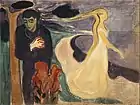 Separation. 1896. 96 × 127 cm. Munch Museum, Oslo
Separation. 1896. 96 × 127 cm. Munch Museum, Oslo The Voice / Summer Night. 1896. 90 × 119 cm. Munch Museum, Oslo
The Voice / Summer Night. 1896. 90 × 119 cm. Munch Museum, Oslo The Kiss. 1897. 99 × 81 cm. Munch Museum, Oslo
The Kiss. 1897. 99 × 81 cm. Munch Museum, Oslo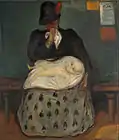 Inheritance. 1897–99. 141 × 120 cm. Munch Museum, Oslo
Inheritance. 1897–99. 141 × 120 cm. Munch Museum, Oslo Metabolism. 1898–99. 172 × 142 cm. Munch Museum, Oslo
Metabolism. 1898–99. 172 × 142 cm. Munch Museum, Oslo Red and White. 1899–1900. 93 × 129 cm. Munch Museum, Oslo
Red and White. 1899–1900. 93 × 129 cm. Munch Museum, Oslo Train Smoke. 1900. 84 × 109 cm. Munch Museum, Oslo
Train Smoke. 1900. 84 × 109 cm. Munch Museum, Oslo Consul Christen Sandberg. 1901. 215 × 147 cm. Munch Museum, Oslo
Consul Christen Sandberg. 1901. 215 × 147 cm. Munch Museum, Oslo Kiss IV. 1902. 47 × 47 cm. Munch Museum, Oslo
Kiss IV. 1902. 47 × 47 cm. Munch Museum, Oslo Four Girls in Åsgårdstrand. 1903. 87 × 111 cm. Munch Museum, Oslo
Four Girls in Åsgårdstrand. 1903. 87 × 111 cm. Munch Museum, Oslo The Brooch. Eva Mudocci. 1903. 76 × 53.2 cm. Munch Museum, Oslo
The Brooch. Eva Mudocci. 1903. 76 × 53.2 cm. Munch Museum, Oslo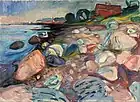 Shore with Red House. 1904. 69 × 109 cm. Munch Museum, Oslo
Shore with Red House. 1904. 69 × 109 cm. Munch Museum, Oslo Portrait of Friedrich Nietzsche (1906). Thielska Galleriet, Stockholm
Portrait of Friedrich Nietzsche (1906). Thielska Galleriet, Stockholm Death of Marat I (1907)
Death of Marat I (1907) Jealousy. 1907. 75 × 98 cm. Munch Museum, Oslo
Jealousy. 1907. 75 × 98 cm. Munch Museum, Oslo The Sun. 1910–11. 450 × 772 cm. Munch Museum, Oslo
The Sun. 1910–11. 450 × 772 cm. Munch Museum, Oslo Galloping Horse. 1910–12. 148 × 120 cm. Munch Museum, Oslo
Galloping Horse. 1910–12. 148 × 120 cm. Munch Museum, Oslo The Yellow Log. 1912. 129.5 × 159.5 cm. Munch Museum, Oslo
The Yellow Log. 1912. 129.5 × 159.5 cm. Munch Museum, Oslo On the Sofa. 1913. 80 × 150 cm. Munch Museum, Oslo
On the Sofa. 1913. 80 × 150 cm. Munch Museum, Oslo Weeping Nude. 1913–14. 110 × 135 cm. Munch Museum, Oslo
Weeping Nude. 1913–14. 110 × 135 cm. Munch Museum, Oslo.jpg.webp) Golgotha.1900.
Golgotha.1900. Workers on their Way Home. 1913–14. 227 × 201 cm. Munch Museum, Oslo
Workers on their Way Home. 1913–14. 227 × 201 cm. Munch Museum, Oslo
Nudes
_by_Edvard_Munch.jpg.webp) Puberty. 1894-95.
Puberty. 1894-95..jpg.webp) The Hands. 1893.
The Hands. 1893.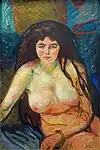 Seated Nude. 1902.
Seated Nude. 1902.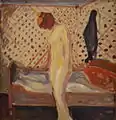 Weeping woman. 1907-1909.
Weeping woman. 1907-1909. Morning Yawn. 1913.
Morning Yawn. 1913.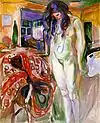 Naked model by the wicker chair. 1919.
Naked model by the wicker chair. 1919.
Self-portraits
.jpg.webp) Self-Portrait. 1882. 26 × 19 cm. Munch Museum, Oslo
Self-Portrait. 1882. 26 × 19 cm. Munch Museum, Oslo_G0192-59_-_Google_Art_Project.jpg.webp) Self-Portrait. 1895. 458 × 314 mm. Munch Museum, Oslo
Self-Portrait. 1895. 458 × 314 mm. Munch Museum, Oslo Self-Portrait in Hell. 1903. 82 × 66 cm. Munch Museum, Oslo
Self-Portrait in Hell. 1903. 82 × 66 cm. Munch Museum, Oslo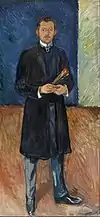 Self-Portrait with Brushes. 1904. 197 × 91 cm. Munch Museum, Oslo
Self-Portrait with Brushes. 1904. 197 × 91 cm. Munch Museum, Oslo Self-Portrait with a Bottle of Wine. 1906. 110 × 120 cm. Munch Museum, Oslo
Self-Portrait with a Bottle of Wine. 1906. 110 × 120 cm. Munch Museum, Oslo
Photographs
 Self-Portrait at 53 Am Strom in Warnemünde. 1907. 89 × 89 mm. Munch Museum, Oslo
Self-Portrait at 53 Am Strom in Warnemünde. 1907. 89 × 89 mm. Munch Museum, Oslo Edvard Munch at the Beach in Warnemünde. 1907. 83 × 87 mm. Munch Museum, Oslo
Edvard Munch at the Beach in Warnemünde. 1907. 83 × 87 mm. Munch Museum, Oslo Self-Portrait “à la Marat”. 1908–09. 81 × 85 mm. Munch Museum, Oslo
Self-Portrait “à la Marat”. 1908–09. 81 × 85 mm. Munch Museum, Oslo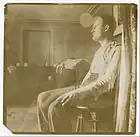 Self-Portrait Somewhere on the Continent I. 1906. 90 × 90 mm. Munch Museum, Oslo
Self-Portrait Somewhere on the Continent I. 1906. 90 × 90 mm. Munch Museum, Oslo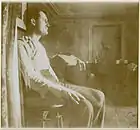 Self-Portrait Somewhere on the Continent II. 1906. 82 × 87 mm. Munch Museum, Oslo
Self-Portrait Somewhere on the Continent II. 1906. 82 × 87 mm. Munch Museum, Oslo Portrait at 26 years
Portrait at 26 years.jpg.webp) Portrait of Edvard Munch 1902
Portrait of Edvard Munch 1902 Portrait of Edvard Munch
Portrait of Edvard Munch.jpg.webp) Portrait of Edvard Munch 1929
Portrait of Edvard Munch 1929 Munch in 1912
Munch in 1912 Rosa Meissner at the Hotel Rohn in Warnemünde. 1907. Photograph. 87 × 73 mm. Munch Museum, Oslo
Rosa Meissner at the Hotel Rohn in Warnemünde. 1907. Photograph. 87 × 73 mm. Munch Museum, Oslo
References
- Gro Finne. "Det overvurderte 'geniet' ". 19 August 2017. Klassekampen. page 49. "Selvfølgelig var det strid om hans banebrytende verk, men han oppnådde internasjonal berømmelse og nasjonal anerkjennelse i sin samtid ved store innkjøp til Najsonalgalleriet, høye priser og utsmykningen av Universitetets aula."
Other websites
- Biography from the Norwegian Ministry of Foreign Affairs
- The Munch Museum
- Gallery Munch - Løten
- Munch at artcyclopedia
- Catalogue raisonné of Edvard Munch's paintings. Archived 2009-03-10 at the Wayback Machine
- Edvard Munch Archived 2010-02-11 at the Wayback Machine
- Interpol's page Archived 2006-03-26 at the Wayback Machine about the stolen works of art
Munch and bipolar disorder:
- Rothenberg A. Bipolar illness, creativity, and treatment. Psychiatr Q. 2001 Summer;72(2):131-47.
- Edvard Munch in Germany Archived 2006-06-14 at the Wayback Machine